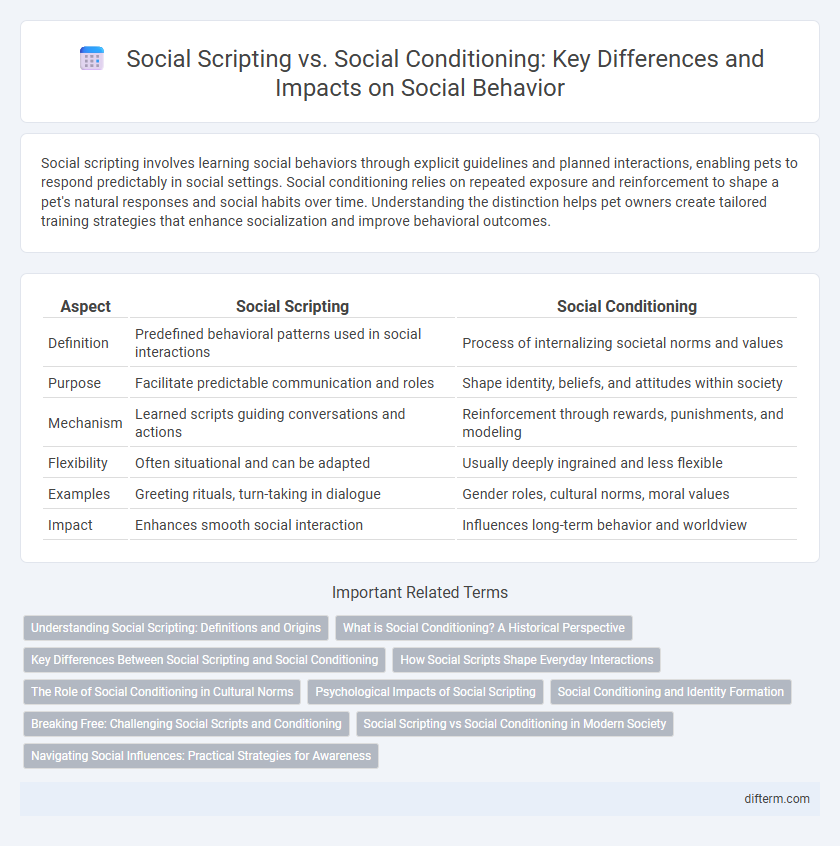Social scripting involves learning social behaviors through explicit guidelines and planned interactions, enabling pets to respond predictably in social settings. Social conditioning relies on repeated exposure and reinforcement to shape a pet's natural responses and social habits over time. Understanding the distinction helps pet owners create tailored training strategies that enhance socialization and improve behavioral outcomes.
Table of Comparison
| Aspect | Social Scripting | Social Conditioning |
|---|---|---|
| Definition | Predefined behavioral patterns used in social interactions | Process of internalizing societal norms and values |
| Purpose | Facilitate predictable communication and roles | Shape identity, beliefs, and attitudes within society |
| Mechanism | Learned scripts guiding conversations and actions | Reinforcement through rewards, punishments, and modeling |
| Flexibility | Often situational and can be adapted | Usually deeply ingrained and less flexible |
| Examples | Greeting rituals, turn-taking in dialogue | Gender roles, cultural norms, moral values |
| Impact | Enhances smooth social interaction | Influences long-term behavior and worldview |
Understanding Social Scripting: Definitions and Origins
Social scripting refers to the learned patterns of behavior and dialogue that guide individuals in social interactions, originating from cultural norms and repeated social experiences. Social conditioning involves the process through which society reinforces these scripts via rewards and punishments, shaping individual behavior over time. Understanding the distinction clarifies how social roles are internalized and performed within different cultural contexts.
What is Social Conditioning? A Historical Perspective
Social conditioning refers to the process by which individuals learn and internalize the norms, values, behaviors, and roles deemed acceptable by their society, shaping their actions and beliefs through repeated exposure and reinforcement. Historically, social conditioning has roots in early human civilizations where cultural practices and social hierarchies were established to maintain order and cohesion within communities. Over time, institutions such as family, education, religion, and media have played pivotal roles in perpetuating social conditioning by systematically transmitting societal expectations across generations.
Key Differences Between Social Scripting and Social Conditioning
Social scripting refers to the learned patterns of behavior and dialogue individuals use to navigate social interactions, often influenced by cultural norms and personal experiences. Social conditioning involves the broader process of acquiring attitudes, beliefs, and behaviors through repeated exposure to societal expectations and reinforcement mechanisms. Key differences include that social scripting is more interaction-specific and dynamic, while social conditioning encompasses the overall internalization of social norms shaping long-term behavior.
How Social Scripts Shape Everyday Interactions
Social scripts provide structured guidelines that shape everyday interactions by defining expected behaviors in various social contexts, enabling individuals to navigate conversations and relationships smoothly. These scripts influence communication patterns, body language, and emotional responses, reinforcing societal norms and facilitating mutual understanding. Repeated social scripting solidifies predictable interaction frameworks, contrasting with social conditioning which broadly molds attitudes and beliefs over time.
The Role of Social Conditioning in Cultural Norms
Social conditioning shapes cultural norms by embedding behaviors, values, and expectations through repeated social interactions and institutional influences. This process reinforces conformity within communities, guiding individuals to internalize societal rules unconsciously. Unlike social scripting, which involves learned conversational patterns, social conditioning fundamentally molds identity and group cohesion by perpetuating established cultural standards.
Psychological Impacts of Social Scripting
Social scripting significantly influences individual behavior by embedding predetermined roles and expectations into daily interactions, which can limit personal autonomy and creativity. This psychological impact often manifests as internalized conformity, where individuals suppress authentic desires to align with societal norms, leading to increased stress and reduced self-esteem. Repeated exposure to rigid social scripts may contribute to identity confusion and hinder emotional resilience by constraining adaptive social responses.
Social Conditioning and Identity Formation
Social conditioning shapes identity formation by embedding cultural norms, values, and behaviors through repeated social interactions, influencing an individual's self-concept and social roles. This process occurs from early childhood, where family, education, and media serve as primary agents reinforcing societal expectations and internalized beliefs. Over time, social conditioning solidifies identity patterns, impacting decision-making and interpersonal relationships within various social contexts.
Breaking Free: Challenging Social Scripts and Conditioning
Breaking free from social scripts and conditioning involves recognizing the unconscious patterns that dictate behavior within cultural and societal frameworks. Challenging these ingrained norms requires critical self-reflection and conscious decision-making to override automatic responses shaped by family, education, and media influences. Empowering individuals to rewrite their own narratives fosters authentic social interactions and promotes personal agency beyond societal expectations.
Social Scripting vs Social Conditioning in Modern Society
Social scripting refers to the learned behaviors and patterns individuals follow in social interactions, shaped by cultural norms and personal experiences, whereas social conditioning involves the deeper, often unconscious, process of internalizing societal expectations through reinforcement and repetition. In modern society, social scripting allows for adaptability in various social contexts, while social conditioning can limit individuality by enforcing conformity to established roles and ideologies. Understanding the distinction highlights how social scripting enables flexible social navigation, whereas social conditioning exerts a more rigid influence on behavior and identity formation.
Navigating Social Influences: Practical Strategies for Awareness
Social scripting involves learned verbal and behavioral patterns that guide interactions, while social conditioning shapes attitudes and responses through repeated exposure to societal norms. Navigating these influences requires increased self-awareness, critical thinking, and mindful observation of one's reactions in social settings. Employing reflective practices and seeking diverse perspectives can help individuals recognize and adjust ingrained scripts and conditioning to foster authentic communication.
social scripting vs social conditioning Infographic

 difterm.com
difterm.com